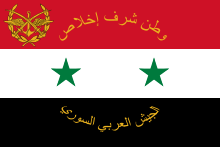18th Armoured Division (Syria)
| 18th Armoured Division | |
|---|---|
|
Syrian Armed Forces Flag | |
| Active | Unknown – present |
| Country |
|
| Allegiance |
|
| Branch |
|
| Type | Division |
| Role | Armoured |
| Size | ~ 7,000 |
| Garrison/HQ | North of Homs |
| Engagements | |
| Commanders | |
| Current Commander | Maj.Gen. Wajih Mahmud |
The 18th Armoured Division is one of two autonomous reserve divisions of the Syrian Arab Army, the other being the 17th Division.
Structure
This is the smallest conventional Division in the Syrian Arab Army with only about 7,000 men.
Its force structure is made up of the:
- 131st, 134th and 167th Armored Brigades
- 120th Mechanized Brigade
- 64th Artillery Regiment
History
Syrian Civil War
It was in reserve role leading up to summer of 2013. Since then it has been heavily engaged in the Syrian Civil War.
The European Council named Major General Wajih Mahmud as commander of the 18th Armored Division in the Official Journal of the European Union on 15 November 2011, sanctioning him for violence committed in Homs.[1] Henry Boyd of the IISS noted that "... in Homs, the 18th Armored Division was reinforced by Special Forces units and ... by elements of the 4th Division under Maher’s de facto command."[2]
On 13 August, clashes took place in Deir ez-Zor city in the Rashdin suburb, as regime forces attempt to storm it. Rebels earlier attacked the cardiac hospital in the city, no reports of losses. 4 rebels killed by clashes in al-Jbeila, Hawiqa and Sina'a neighborhoods.[3][4]
As of 20 August, the western Hawiqa neighborhood, including the local Baath Party headquarters, had fallen to the rebels. The opposition claimed that 160 government soldiers and dozens of rebels had died in the fight for Hawiqa. Government forces retaliated by bombarding the rebels from their positions in the Joura and Ghazi Ayyash districts. The Free Syrian Army-affiliated Ahfad al-Rasul Brigade, recently supplied by Qatar with anti-aircraft missiles, played an important role in taking Hawiqa.[5]
On the same day, the Army hit rebel forces in Hawiqa district with tanks and multiple rocket launchers, and also battled them in territory separating Hawiqa from the district of Joura, opposition sources in the city said. The government was trying to regain Hawiqa because it could not afford the rebels to be so close to its most important stronghold of Joura and the Army camp there. Air force intelligence and military intelligence, two important security compounds in the city, were also located in the nearby Ghazi Ayyash district, and came within the range of rebel rocket-propelled grenades.[6]
See also
References
- ↑ "Council Implementing Regulation (EU) No 1151/2011 of 14 November 2011 implementing Regulation (EU) No 442/2011 concerning restrictive measures in view of the situation in Syria" (PDF). Official Journal of the European Union. 15 November 2011.
- ↑ Boyd, Henry (12 March 2012). "Shades of Hama and Grozny in Homs and Idlib". International Institute for Strategic Studies.
- ↑ "Dozens of Syrian soldiers and rebels killed as opposition advances on Deir Ezzor, Agence France-Presse". The National. Abu Dhabi. 13 August 2013.
- ↑ "Deir Ezzour province". Facebook.com.
- ↑ Yacoub, Khaled (20 August 2013). "Assad's forces counter rebel gains in Syria's Deir al-Zor – Yahoo News". Yahoo! News.
- ↑ http://www.reuters.com/article/2013/08/20/us-syria-crisis-east-idUSBRE97J0P520130820
